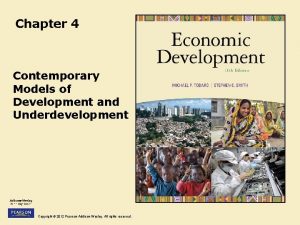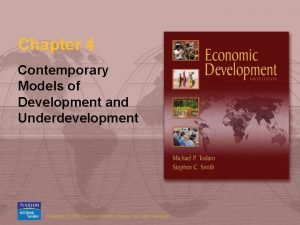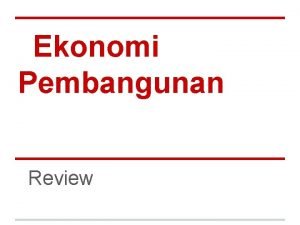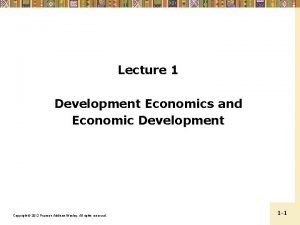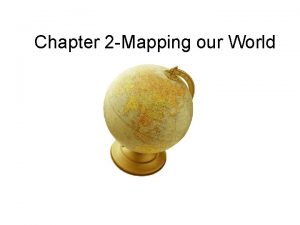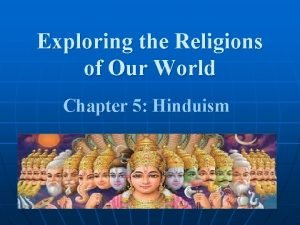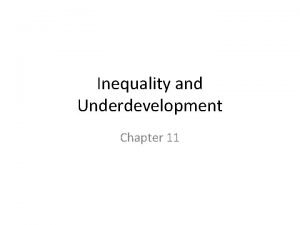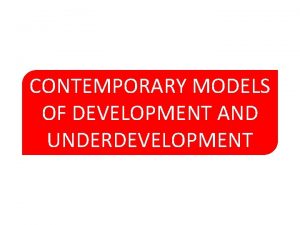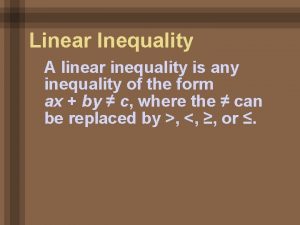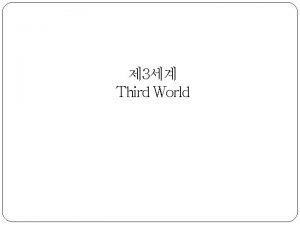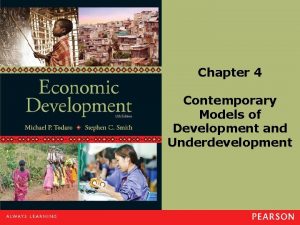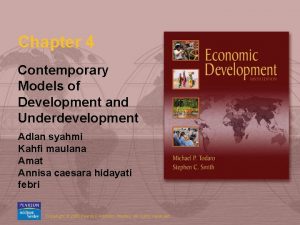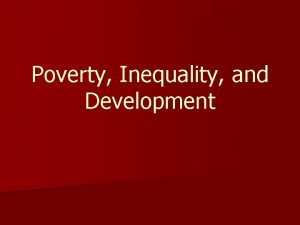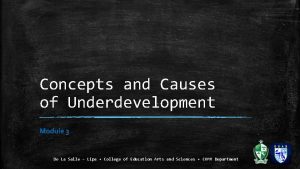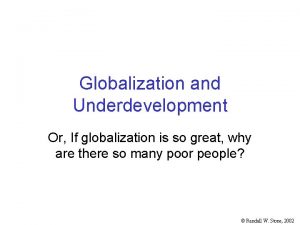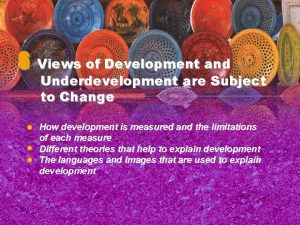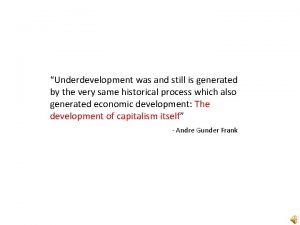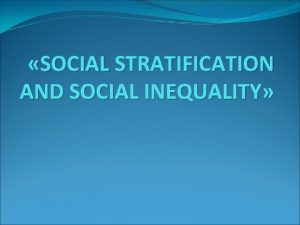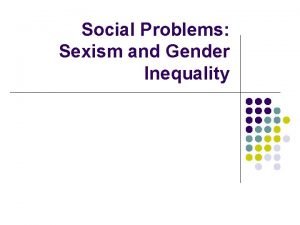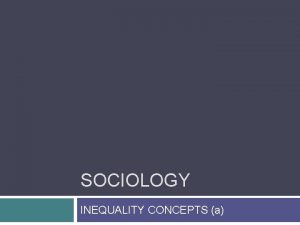Inequality and Underdevelopment Chapter 11 Our world has

































- Slides: 33

Inequality and Underdevelopment Chapter 11

“Our world has never been more connected or more prosperous than it is today. Yet right now, one in every three of us alive today does not have access to the most basic needs for a decent life - food, education, medical care, a safe environment. ”


• With so much wealth in the world, why is there still so much poverty? • Global poverty began with military conquest, slavery and colonization that resulted in the seizure of land, minerals and forced labor. • Today, the problem persists because of unfair debt, trade and tax policies -- in other words, wealthy countries taking advantage of poor, developing countries.

• How today's financial crisis is a direct consequence of these unchallenged policies that have lasted centuries? • Consider that 20% of the planet's population uses 80% of its resources and consumes 30% more than the planet can regenerate. • At this rate, to maintain our lifestyle means more and more people will sink below the poverty line. • Can we really end poverty within our current economic system?

Poverty Facts and Statistics • Almost half the world — over three billion people — live on less than $2. 50 a day. • At least 80% of humanity lives on less than $10 a day.

• In 2005, the wealthiest 20% of the world accounted for 76. 6% of total private consumption. The poorest fifth just 1. 5%

• The poorest 10% accounted for just 0. 5% and the wealthiest 10% accounted for 59% of all the consumption

Global inequality and underdevelopment • What is the (global) North-South divide? • How has it emerged, how is it reproduced, and what can be done about it? • Has the recent era of ‘globalization’ eroded a North-South divide and promoted some form of convergence, or poverty reduction, in the global order?

Debate over the relationship between globalization, inequality and underdevelopment: (I) (1) Is there a shift towards convergence between rich and poor countries in the global economy? (optimists) v The argument is that poverty has been reduced because globalization presents opportunities to developing countries. v Dispersal of capital flows throughout the world v The rise of manufacturing in the developng world v The rise of China and India v Increase in the primary commodity prices in recent years( thus high growth rates in Latin America and much of Africa).

Debate over the relationship between globalization, inequality and underdevelopment: (II) (2) More sceptical assessment which questions the extent to which poverty has been reduced (sceptics) v there is increase in inequality within countries and between them v Capital and high value production is highly concentrated in the developed countries v There are limits of the kind of manufacturing that has taken place in much of the developing world( India and China) v Excessive relience on primary commodity exports in the periphery. According to that view these problems have been exacerbated by the economic downturn since 2007 -8.

The Debate over the Causes of Global Inequality and Underdevelopment(1940 s-1970 s) Two basic positions can be identified: (1)Modernization (2)Dependency theories

Modernization • • • This was the mainstream theory of development which argued that developing societies- the ‘Third World’- were backward and undeveloped, and therefore in need of development (Kiely, 2013, p. 150). This position was most famously developed by Walt Rostow(1960). Rostow suggested that all nation-states pass through similar stages of development. Poorer societies in 1960 s were at a similar stage of development to, say, Britain in the 1780 s. Thus we can hasten the transition to development in the poorer societies. Development could be facilitated by poorer countries embracing Western investment, technology and values such as entrepreneurship and meritocracy. This theory indicates that the development and modernization could occur through industrialization. Critique: We should take into account the diversity among Western socities in terms of the transition to development and the reality of modernity in the 1950 s.

Dependency theories • Dependency theory challenged the view that development and modernization could occur through industrialization, suggesting that industrialization remained dependent on the West through reliance on foreign capital, foreign technology and foreign markets. • Industrialization in the developing world was highly exploitative and reliant on cheap labour and it promoted new forms of subordination, hierarchy and dependence in the world economy.

Both sides in the debate suffered from some similar weaknesses. Ø They tended to over-generalize and homogenise a diverse set of countries. They made predictions concerning the inevitability of development( modernization theory) or stagnation(dependency theory). However, newly industrialized East Asian countries such as South Korea and Taiwan grew rapidly and exported to Western economies while protecting certain sectors from foreign competition to develop their own national industries.

• Changes in the global economy led to important changes in development strategy in the Third World. After the debt crisis of 1982 more neoliberal policies that encouraged trade and investment liberalization, privatization and the rollback of state intervention in the economy came into being. • “…the optimistic and sceptical accounts of growth, poverty and inequality replicate these older debates in the new context of globalization”(Kiely, 2013, p. 153).

Colonialism • It begins in 1492, with the Spanish and Portuguese conquest of the Americas. • Not only was the mineral wealth of Latin America plundered, the indigenous economies were destroyed by forced mining on a massive scale and the creation of plantation agriculture. • The creation of an economy based on the export of raw materials has remained a structural problem to this day.

Colonialism • The loss of land was a major effect of colonialism. • In Latin America, Africa, and Asia, dual economies were the result, with the majority of people forced to work for the new landowners. • After political independence, little changed. The new masters of the latifundia and plantations were the local inheritors of the colonial system, with all of its inequalities. Land rights struggles have continued into the 21 st century.

Slavery • Slavery was formally abolished throughout the world in the 19 th century, and yet it continues on every continent, with at least 80 million people still forced to work under slave-like conditions for others. In Brazil, as the film shows, certain categories of workers are still referred to as slaves. • Destruction of local crafts (especially weaving and ceramics) was another feature of colonialism that has left its mark on modern economies. The colonized regions of the world were set back by two centuries in the development of manufacturing, which is why they have had such great difficulty creating integrated economies in recent decades. • As if the direct economic damage imposed by colonialism were not bad enough, the colonizers also destroyed the cultures of the places they dominated. To force people off the land into the mines and the plantations, the colonizers had to disrupt a communal way of life by teaching people to disregard their own traditions. Missionaries thus played an important role in the subjugation of the mind.

The World Bank and the International Monetary Fund • After political independence, new forms of control were developed, with the World Bank and the International Monetary Fund playing the role of the economic police force of the rich nations to keep the poor nations in check. • The most important instrument of control has been international debt. The former colonial governments illegally saddled their former colonies with that debt when they departed, knowing that the combination of debt and an economy based on raw-materials exports would keep the former colonies in a state of dependence. Through debt and dependence, the South finances the North, sending far more of its economic surplus to northern banks than they receive in foreign aid. Perhaps this would not be so bad if the money borrowed had helped the poor in some way, but in fact the loans mostly went to build vanity projects for the elites, not the kind of infrastructure that helps the poor, who are left paying off the debt anyway.

• In the 1970 s, a number of countries in the global South were starting to climb out of poverty and gain some degree of economic autonomy. But after the global depression of 1982, engineered by policies in the U. S. , the South became far more heavily indebted. • That gave the IMF leverage over the governments of the poor nations, which they used to impose structural adjustment policies. • In particular, following the neoliberal Washington Consensus, they required many governments to privatize services, include communications, transportation, education, health care, and water supply. The loss of some of those services was, for the poor, a matter of life and death.

• Neo-liberalism also led to 1) opening up countries to short-term capital flows--which resulted in destabilizing their economies, 2) reduced taxes on luxury imports and higher taxes on subsistence commodities--which meant higher taxes on the poor, 3) trade liberalization--which reduced the chances of poor countries to develop using the same techniques that developed countries had followed in previous centuries. In general, ideology won out over practicality, and the poor suffered as a result.

• Free trade, another mantra of the neoliberal Washington Consensus, has also been promoted in bad faith. While rich nations have insisted that Third World countries lower their trade barriers, the U. S. and Europe have blocked imports of manufactured goods from poor countries and have subsidized the production of cotton, sugar, and other commodities, and then flooded world markets with their overproduced goods.

• The film offers a few specific policy changes that are needed to end poverty: 1) cancel debts, 2) create fairer trade arrangements, 3) impose taxes on wealth, not consumption of necessities, 4) end privatization of natural resources, 5) develop land reform that shares land, or its value, among the actual producers of farm products, and 6) initiate programs of de-growth in the North, to reduce wasteful consumption.

• However, the film does not suggest that the adoption of those policies would end poverty in the world. The closing theme is the necessity of sharing the resources of the earth equitably. Any person or nation that hoards them causes suffering among others. Yet the unequal distribution of resources is now built into the structure of the global economy. Thus, solutions must go much deeper than any set of specific policies. The process of overcoming five hundred years of oppression on a global scale cannot be reversed without a deep transformation of institutions. Even if the World Bank and the IMF adopted new priorities tomorrow, if debts were canceled, and fair trade policies were implemented (though all of that would help), the legacy of domination would not suddenly come to an end. For that reason, the film does not emphasize a finite list of solutions at the end. Instead, it asks viewers to ponder the changes our lives must undergo in the North for us finally to take responsibility for the ongoing impoverishment of the South.

Global Inequality and underdevelopment: the optimistic position ü Main argument of this position; underdevelopment reduced in recent years, thus global inequality and absolute poverty too. ü The main evidence; # or proportion of people living in absolute poverty has declined since the 1980 s. This is the result of high rates of economic growth caused by policies of trade and investment liberalization. ü The clear implication is that poverty is a result of insufficient globalization, and this is a policy choice made by states in developing countries. (Kiely, 2013, p. 153) Figures: 1. 8 billion people in 1990 1. 37 billion people in 2005 1. 2 billion people in 2013 Ø “The number of people living on less than $1. 25 per day has decreased dramatically in the past three decades, from half the citizens in the developing world in 1981 to 21 percent in 2010, despite a 59 percent increase in the developing world population. ” http: //www. worldbank. org/en/news/pressrelease/2013/04/17/remarkable-declines-in-global-povertybut major-challenges-remain

• “However, despite its falling poverty rates, Sub-Saharan Africa is the only region in the world for which the number of poor individuals has risen steadily and dramatically between 1981 and 2010. • There are more than twice as many extremely poor people living in SSA today (414 million) than there were three decades ago (205 million). • As a result, while the extreme poor in SSA represented only 11 percent of the world’s total in 1981, they now account for more than a third of the world’s extreme poor. • India contributes another third (up from 22 percent in 1981) and China comes next, contributing 13 percent (down from 43 percent in 1981). ” http: //www. worldbank. org/en/news/pressrelease/2013/04/17/remarkable-declinesin-global-poverty- but major-challenges-remain

• “Adoption of the correct policies, which involves the promotion of a “globalization-friendly” strategy is the key point for the optimists. • This means adopting policies that allow countries to embrace the opportunities generated by the world economy, and this in practice means liberalization. ”( Kiely, 2013, p. 153) • “Liberalization means competition and specialization, rather than protection, so that tarrifs and subsidies are reduced, import controls are removed, and restrictions on foreign investment are loosened. ”

The sceptical position There are structured inequalities that constrain late developers, making it difficult to overcome inequality and underdevelopment. Why? (1) Foriegn investment has increased but it remains concentrated in the developed world. (2)The type of manufacturing that is generally occurring in the developing world is not necessarily overcoming underdevelopment. By the end of the 1990 s, developing countries as a whole accounted for only 10 per cent of total world exports of goods with a high research and development technological complexity and/or scale component( UNCTAD 2002 cited in Kiely, 2013, p. 158). Skills and wages are low in developing countries. They do not have high value sectors* that simply means intense competition and conditions determined by cost price, which in turn means low wages. • Ø According to optimistic, this should be seen as a necessary stage that developing societies must pass through. In the long run, this type of competitive industrialization will lead to full employment and more developed kind of manufacturing. This was the case in earlier developers. *Higher value production; high start-up and running costs and significant skill levels.

Why does inequality matter? What are the alternatives? • Often the argument is that it is an inevitable feature of all societies, and it is better to have a richer but unequal society, than a more egalitarian but poorer society. • An additional argument made is that inequality does not matter so long as people are lifted out of poverty.

Three responses to this argument (1) It would be an unintended outcome of social interaction but efforts should be made to alleviate it. We are responsible to alleviate inequality. (2) Inequality is socially and economically dysfunctional. It can be linked to crime and anti-social behaviour. (3) The wealth of a specific rich individual is not caused by the poverty of a specific individual in the developing world. But both are part of a social order which encourages the concentration of capital in some areas and marginalization in others.

Alternatives to neoliberalism • The current financial and economic crisis may lead to a new international order. More managed capitalism along the lines of the Breeton Woods order would reemerge. • But this does not mean the end of neoliberalism.

References • Kiely, Ray, Inequality and Underdevelopment in Beeson and Bisley, Issues in 21 st Century World Politics, Palgrave, Macmillan, 2013
 Multiple equilibria a diagrammatic approach
Multiple equilibria a diagrammatic approach Contemporary models of development and underdevelopment
Contemporary models of development and underdevelopment Contemporary models of development and underdevelopment
Contemporary models of development and underdevelopment Peason
Peason Lesson 1-6 compound inequalities
Lesson 1-6 compound inequalities Awareness of ourselves and our environment is:
Awareness of ourselves and our environment is: Awareness of ourselves and our environment
Awareness of ourselves and our environment Awareness of ourselves and our environment
Awareness of ourselves and our environment Awareness of ourselves and our environment is:
Awareness of ourselves and our environment is: Judaismn
Judaismn Exploring the religions of our world chapter 1 pdf
Exploring the religions of our world chapter 1 pdf Chapter 2 mapping our world
Chapter 2 mapping our world Chapter 2 study guide mapping our world
Chapter 2 study guide mapping our world Compound inequalities real world examples
Compound inequalities real world examples Ap world history chapter 25 africa and the atlantic world
Ap world history chapter 25 africa and the atlantic world Thinking affects our language which then affects our
Thinking affects our language which then affects our Our census our future
Our census our future Ok 313
Ok 313 Marcus aurelius our life is what our thoughts make it
Marcus aurelius our life is what our thoughts make it We bow our hearts
We bow our hearts Our census our future
Our census our future Our life is what our thoughts make it
Our life is what our thoughts make it Our collective madness is for *
Our collective madness is for * God our father christ our brother
God our father christ our brother Our future is in our hands quotes
Our future is in our hands quotes Who have believed our report
Who have believed our report It has become appallingly obvious that our technology
It has become appallingly obvious that our technology Dave grolsh
Dave grolsh Who wrote it has not escaped our notice
Who wrote it has not escaped our notice Seated on high the undefeated one
Seated on high the undefeated one It has come to our attention
It has come to our attention Our company has been established
Our company has been established Exploring the religions of our world pdf
Exploring the religions of our world pdf World heritage is our heritage slogan
World heritage is our heritage slogan
